Family : Laniidae

Text © Dr. Gianfranco Colombo

English translation by Mario Beltramini
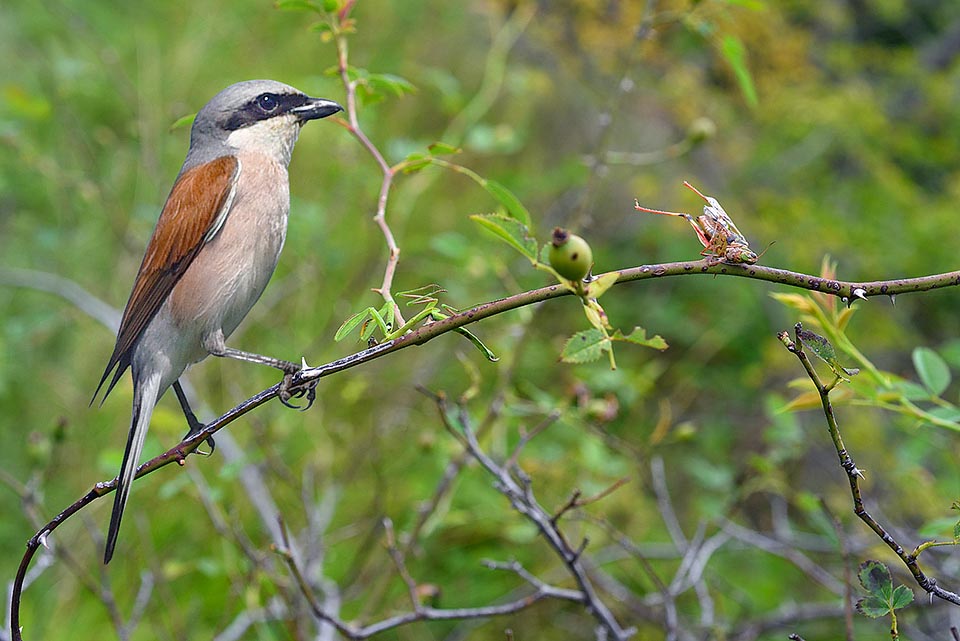
A Red-backed shrike (Lanius collurio) with its macabre pantry, that then often it fails to use, of agonizing preys, impaled live on the thorns of a wild rose. It's a bird that pitiless, for pleasure hunts the all day small vertebrates usually frogs or mice, and big insects, even when sated and without mouths to nourish © Gianfranco Colombo
This winged creature drags from centuries a quite ugly but well-deserved reputation, seen that its usual conduct leads it to commit with absolute normality misdeeds of remarkable ruthlessness. In nature do exist many animals that have fierce behaviours, some are predators and hunt other similars for eating them, others adopt ways that for us, human beings, appear “inhumane” and that we call “ravening wolves”, others still having a repulsive and disgusting behaviour, like the necrophagous animals but none seems to behave with so much wickedness and inopportunity like the shrikes.
On the other hand this blemish is regularly resumed in all languages, so much to prove how much true is the feeling that this bird has given to all those who have known it.
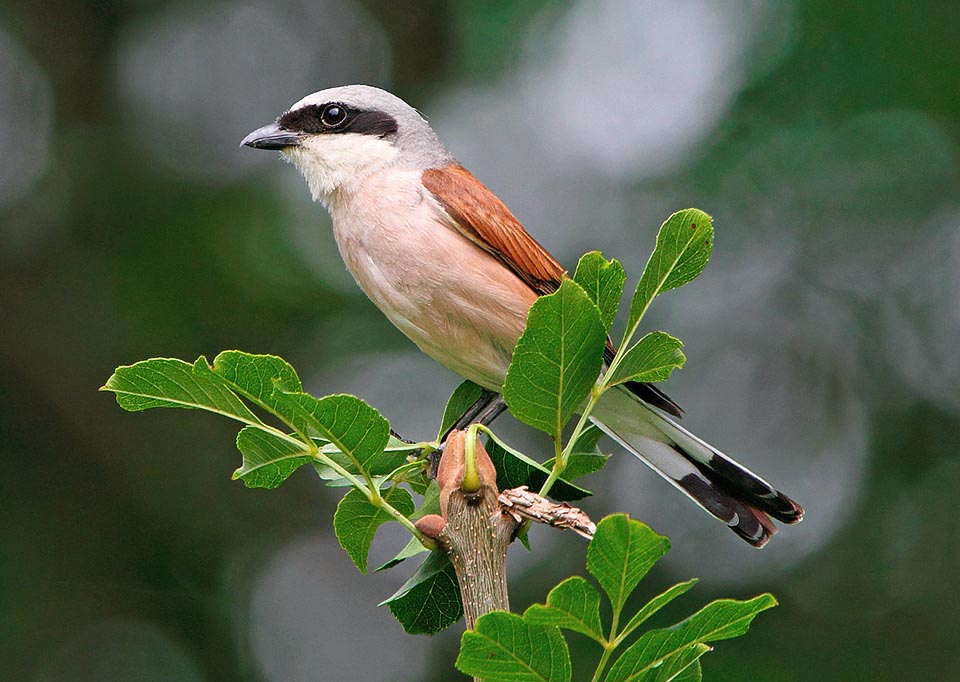
The beak is very robust, strong and massive, conical and hooked, almost like a raptor and a showy black bandit-like mask covers the eyes of the male © Luigi Sebastiani
Lanius from the eponymous Latin term that means butcher and collurio from the Greek “kollurion”, name already mentioned by Aristotle to indicate a small bird having particular aggressive attitudes and probably identified in a shrike.
Actually, in Germany they have called it also Neuntöter (nine dead) to indicate that before eating it kills nine victims and even Rotrückenwürger (destroying angel) for analogous reasons! But what will it do of so bad this small bird to get such a bad reputation?
The red-backed shrike spends the whole day hunting its preferred preys that vary from small animals to big insects and does so even without having the necessity and even when already sated.
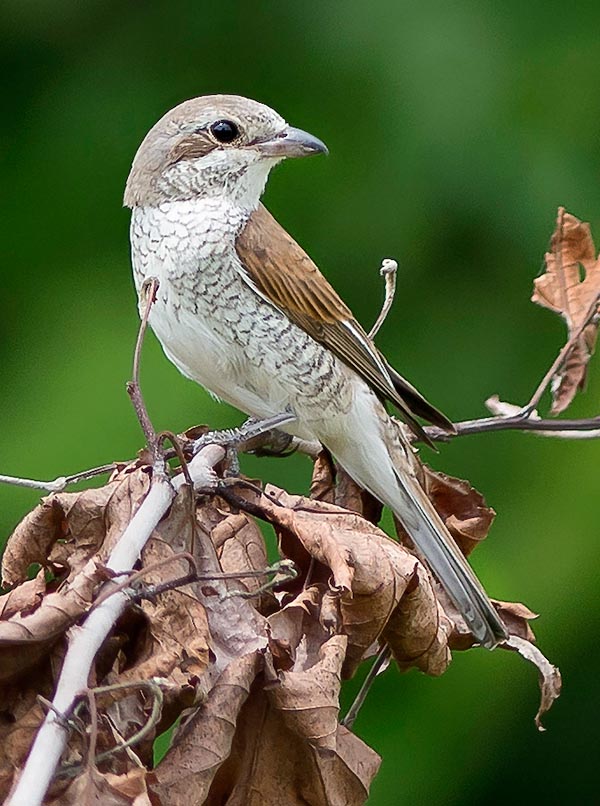
In the female this mask is just hinted. It has has a livery completely of matte rusty colour, with cream chest, strongly spotted, like a sparrow hawk, by small blackish marks © Gianfranco Colombo
Nothing strange, so far, if it were not for the uselessness of seizing preys more than needed but the striking fact is that these victims are brutally impaled on spines or barbed wire fences and there abandoned to the public derision. So, we find uselessly skewered small frogs, coleopterans, small mice and many other insects.
In Europe it is called Red-backed Shrike in English, Neuntöter in German, Alcaudón Dorsirrojo in Spanish, Pie-grièche écorcheur in French, Picanço de dorso ruivo in Portuguese and Averla piccola or Averla minore in Italian.
Other dialectal Italian names are redestoea, gherla, scavassua, giarla, garla, muscarate, gerlato, laniere, smerlo scorticatore, gàstriga, gagèt, sgazetù, farlotto, ghierla, gazzina, avèlia e vèrla.
The common Italian name of averla does not have a sure etymology and might come from some dialectal form wrongly transcribed or wrongly pronounced, even if some think that the original form of the name “averula” may come from the Latin “ave querula” = mournful bird, due to the awkward song it usually emits, Latin then become macaronic and replaces by vulgar languages in averla.
Clearer is the etymon of the English name shrike, traditionally used in the ornithological world to indicate all laniids of the planet that has instead onomatopoeic derivations. The verb “to shriek” rightly means in English to scream and partially imitates the unpleasant sound emitted by this small bird when it informs of its presence and comes, or originates, the names that the north European populations have given to this grouping of small birds. Skrikja, shrieker, skrika in the Scandinavian peninsula and Schrik in German.
Zoogeography
The red-backed shrike is a long range migratory bird: it spends the summer in the Palearctic whilst in winter it shelters in tropical areas, passing the Equator. It occupies diffusely the whole European continent in the eastern part to reach the central-Asian plains and southward limiting to Anatolia and occasionally in Middle East. In Europe it is absent in the northern part of the Scandinavian peninsula, in England and in Ireland where it has become very rare, in the northern part of France, in Benelux and in most of the most of the Iberian peninsula. In Italy, it occupies the whole peninsula with rare presences in Puglia and Sicily.
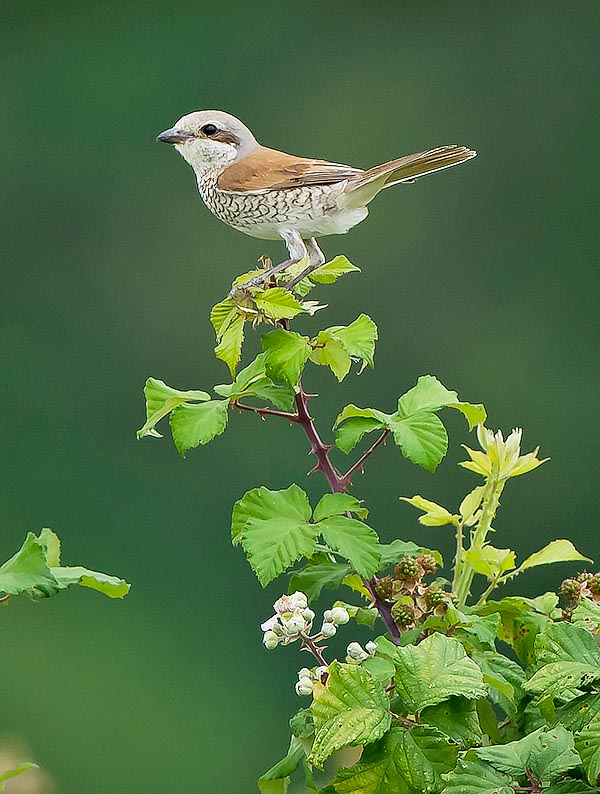
It is 18 cm long with an about 28 cm wingspan and a weight of 30-35 g. When resting, the tail is continuously moving, up and down tirelessly as if it would serve to keep balance © G. Colombo
The country was disseminated with banks with pollarded plane-trees, mulberry trees and vineyards rows, small fruit orchards, plenty of brambles and a vastity of stable meadows subject to periodical and with traditional means irrigation, a natural environment where the insects swarmed exceedingly.
Then suddenly, the agriculture changed method and type of cultivation, transforming the environments initially natural, in monocultured deserts, with huge extensions of corn and soy and with the indiscriminate use of pesticides and herbicides, with consequences easy to imagine.
Its presence has become now very discreet and occasional so much to talk of it as a terrible debacle for this species. In some areas where this industrialization has not been very successful, the species has maintained good levels of presence but overall all the populations present in the primitive territories underwent, by the end of last century, a terrible stop.
All populations winter in Africa with a greater presence in the eastern side but occupying diffusely all southern part.
Ecology-Habitat
The variety of the habitat frequented by the red-backed shrike and the remarkable adaptability of this bird to the various habitats of the Palearctic, have rendered difficult the full understanding of the reasons that have made possible this sudden disappearance. It could be thought that with the decrease of habitat in some areas, it originated balancing developments in other zones or even an addiction to the new environmental needs. It is therefore not yet total understood the real reason of the dramatic decrease of this species.
The frequented habitat is an open area, at the limit of treed zones, rows of trees in a cultivated country, hills with low and spiny bushes, steppes, uncultivated meadows at altitudes going from the sea level up to about 2000 m.
The hilly zones up to 1000 m are the eppicentre of its habitat even if in the northern zones it is placed at the limits of the taiga woods, in the open spaces close to the coniferous forests. It does not frequent woods and area highly treed if not accidentally during the migration.
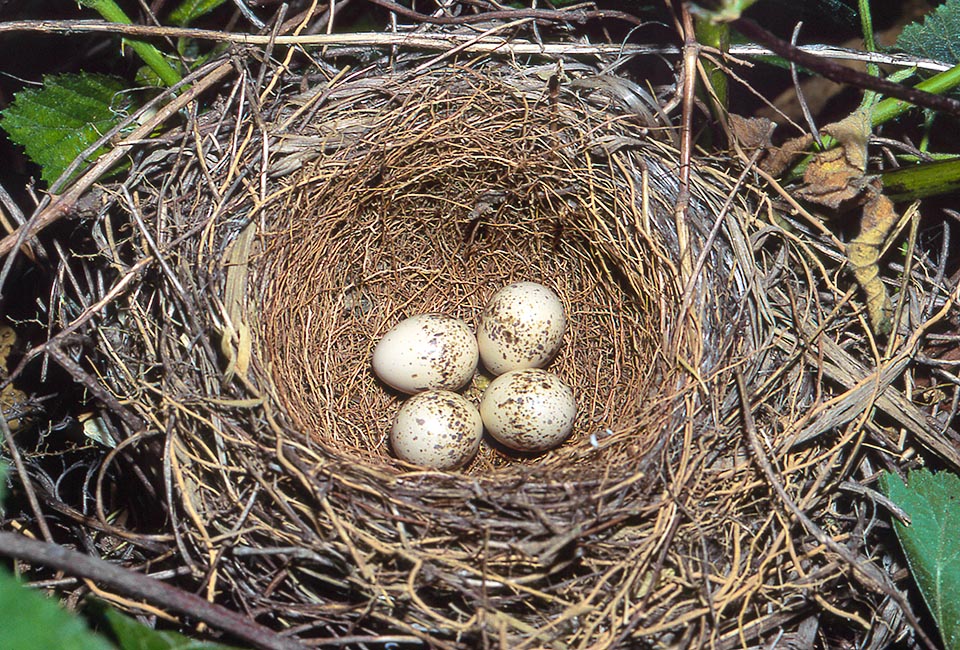
The red-backed shrike is a long range migrant: spends the summer in the Eurasian Palearctic, whilst in winter shelters in tropical areas, passing the Equator. The nest is built almost totally by the male that gets in the reproduction sites a few days before the females. Placed among brambles, little high from the ground, contains 4-6 cream white eggs dotted of reddish small spots in the amplest part forming a well marked crown, hatched for 2 weeks by the female © Museo Civico di Lentate su Seveso
Morpho-Physiology
The red-backed shrike is a charmful small bird with bright colours in the male and more attenuated and discoloured in the female. The male exhibits an ash-coloured head getting down up to the shoulders to change then in an intense and bright hazelnut coloured mantle, marked by black remiges. Also the rump is ash grey and accompanies a very white tail, with a jet-black terminal band. The central flight feathers are black and when flying they are very showy and display the drawing of a big inverted T.
The tail is an element of the body very evidenced by the red-backed shrike. When resting, it moves it continuously, raising and lowering it as if it used it for keeping in balance and when flying it’s a determinant part for distinguishing this bird from other similar species.

The pullets are nourished by both parents and grow fast spreading very precociously around the nest © Museo Civico di Lentate su Seveso
The female has a livery completely of matte rusty colour, whilst the cream chest is highly spotted by small blackish marks, similar, on a reduced scale, to those of the Sparrow hawk (Accipiter nisus). Also, has the typical bandit mask even if less accentuated than the male. The young are similar to the female but with slightly more marked shades and more accentuated grizzle.
The red-backed shrike has a flight fast and straight but in the mean time also agitated and a little messy, with nervous movements and rapid wingbeats, often asynchronous. Its song is characteristic and corresponds to a little dry grubbing and continuously repeated. Its clumsy “ghè ghè ghè” emitted typically from the top of a tree or of a bush, can be easily heard even from very far away. Conversely, the song love is a faint and soft melody emitted shortly, “tight-lipped”, as if it was uniquely reserved to its partner.
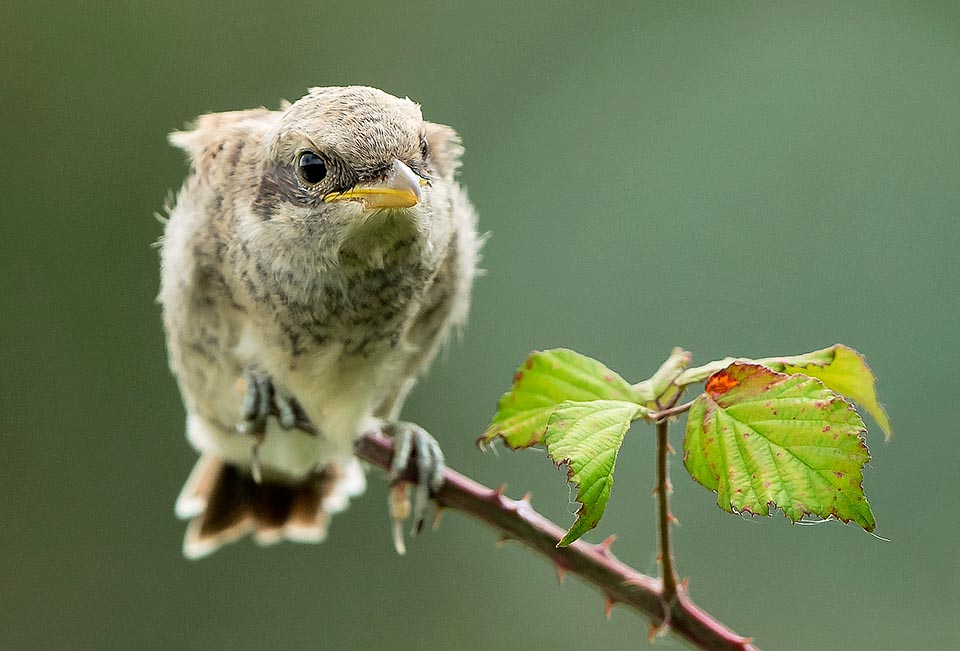
The first steps among the branches are difficult, but parents do not abandon them and care the chicks for various weeks © Gianfranco Colombo
Ethology-Reproductive Biology
The male anticipates of a few days the arrival of the females in the reproduction sites and, found the suitable location, occupies it immediately waiting for the partner to come.
The red-backed shrike arrives quite late in the summer quarters and belongs to the last seasonal migratory wave that includes some typical long range migratory birds. It is contextual to the Common quail (Coturnix coturnix) and the Golden oriole (Oriolus oriolus), the European turtle dove (Streptopelia turtur) and the Nightjar (Caprimulgus europaeus), birds that remain with us a few months, just the time to grow up one single hatching.
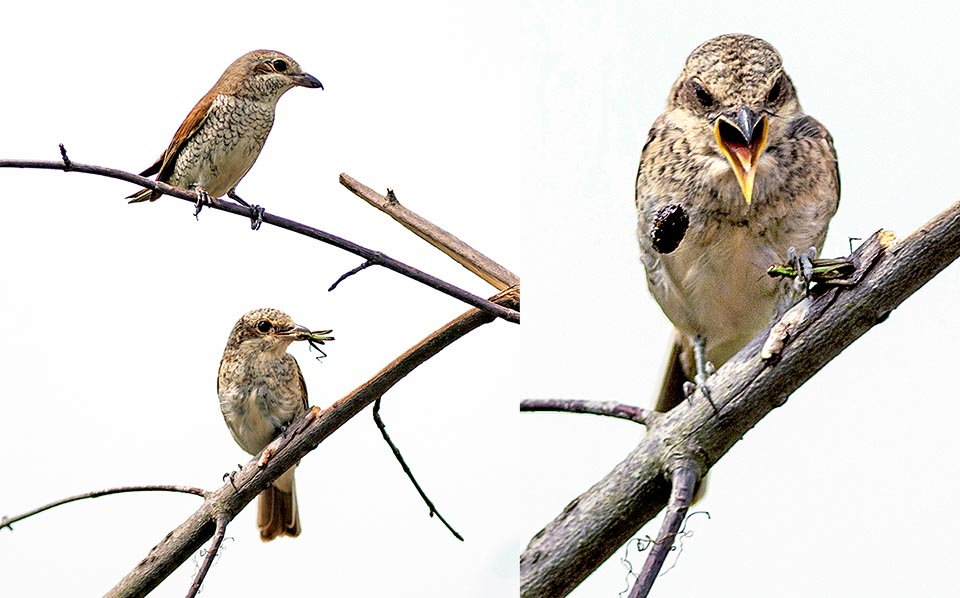
Here mum has just offered a grasshopper, but the young puts it under the foot and gets free of a pellet, the lumped leftovers of the previous meals © Gianfranco Colombo
A platform is constructed with small stems over which is put some herbaceous material increasingly finer such as small roots and dried grasses to form a well drawn and deep cup. Are laid 4 to 6 cream white eggs, spotted of reddish small dots in the amplest part to form a well defined crown.
The brooding done by the female lasts 14 days but the young are very impatient and often jump out from the nest precociously scattering all around. The parents in any case care them for various weeks more before they get independent.
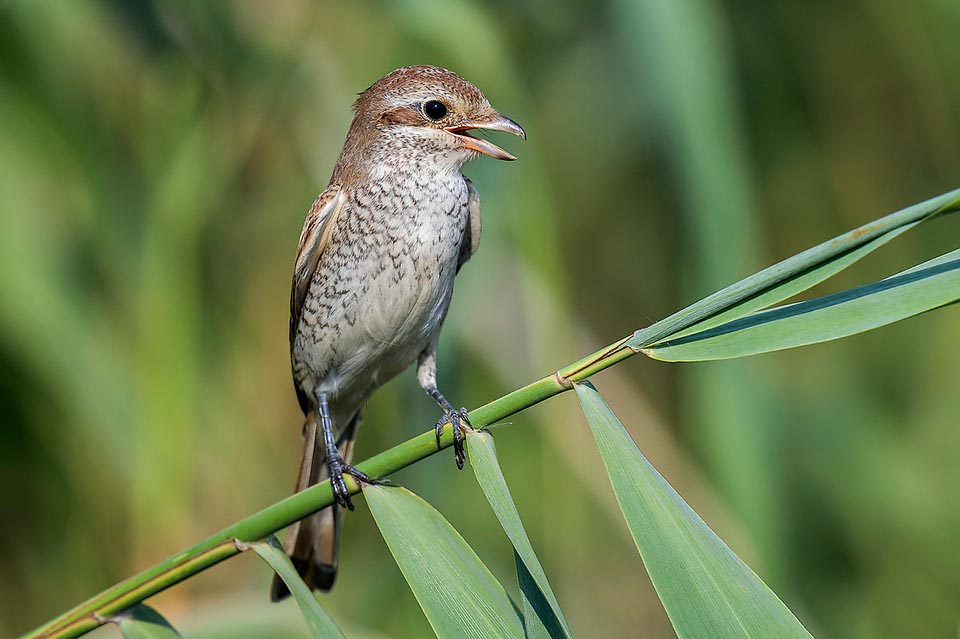
A now grown male that will soon get the adult livery. Since some decades the Lanius collurio is a species in clear decline in the plains of central-northern Europe, possibly due to the environmental changes linked to the agriculture and pesticides, but seen its vast distribution area it is not presently considered as endangered © A. Cervigni
A joke for the comic books readers and referred to this small bird. If you well observe the livery of the red-backed shrike, you will note that it has always a showy black mask on the face, of the type of that worn by the Beagle Boys of the series of Donald Duck cartoons. An atavistic indication of its bad habits or perhaps nature has deliberately masked it in order to hide, to the surrounding world, the face of a wicked bandit? It would be nice to think that Walt Disney did merely copy this bird to create one of his characters of Duckburg.
→ To appreciate the biodiversity within PASSERIFORMES please click here.
